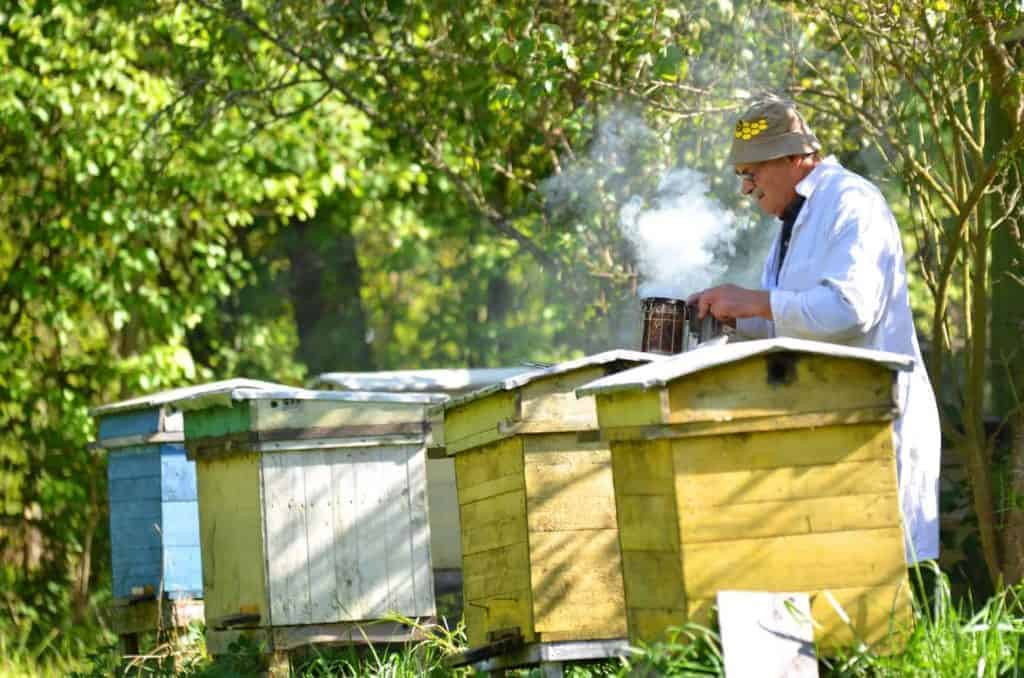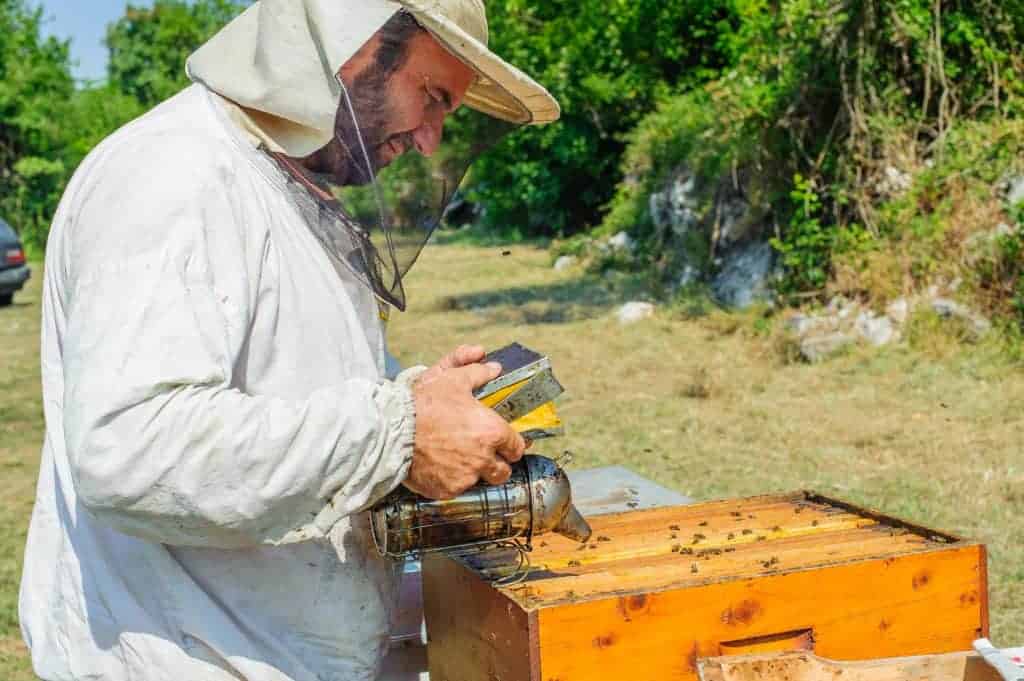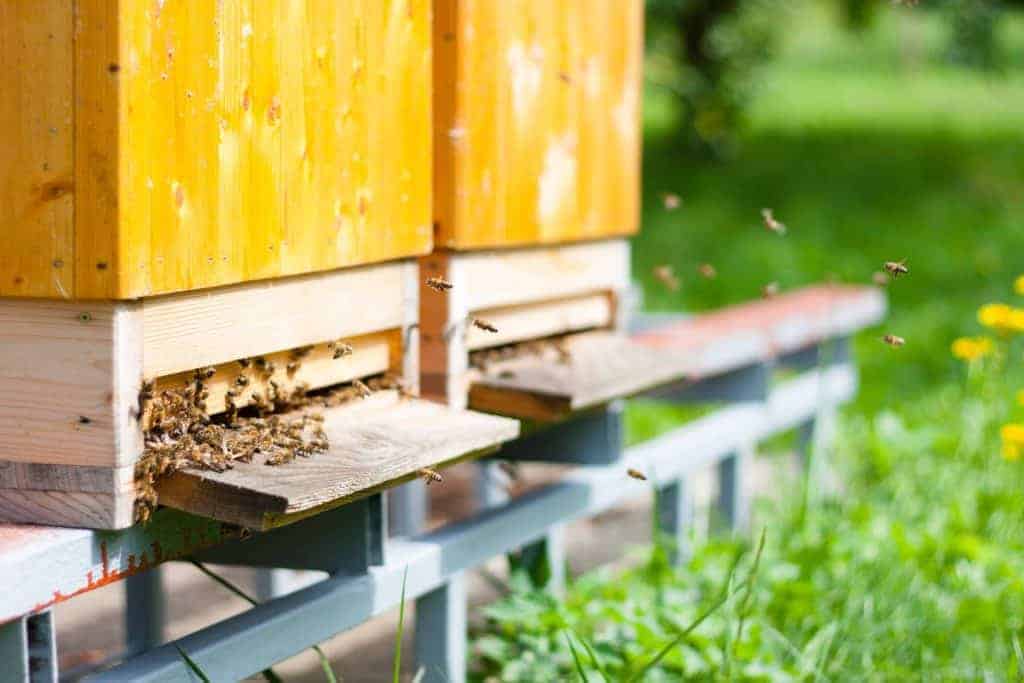Calm bees and calm beekeepers
There are few things more relaxing to a beekeeper than setting a chair close to the hive on a summer day and watching the beautiful activity to and from the entrance. The activity of workers leaving from and returning to the hive is a gloriously comforting sign. Likewise, the fanning of the hive at the entrance by other workers and perhaps some drones is a great reminder of the collaborative nature of a colony.
While many beekeepers enjoy this experience, to really gain a deep understand what’s happening in the hive we often choose to conduct a hive inspection. This is an opportunity to get close to our bees, as we explore and try to better understand their world.
Unfortunately, the beehive inspection is not always the quiet, easy and relaxed affair we would like to experience. Sometimes our bees take to offense to our presence – and have no problem letting us know!
How can we assess our bees response during a hive inspection? And what can we do to increase the chances of the calm enjoyable encounter we desire during our inspections?
Why bees may not always be calm
Let’s face it, no-one enjoys aggressive bees. So let’s first consider the factors that could turn our bees a little more aggressive, during any one inspection.
There are a few…
- Beekeeper behavior (this is one of the most common reasons – see below)
- Race of bees
- Weather conditions and temperature
- Time of year
- Availability – or lack thereof – of foraging resources, such as during a nectar dearth
- Availability of a queen
- Productivity of the queen
- The “personality” of the colony (yes, they can differ considerably)
- The presence of pheromones
- Other
The last one (“other”) is not to be ignored. Over time beekeepers learn about their individual hives and come to expect a certain reaction from each. But, during any one inspection a different response may be seen, such as a more aggressive reaction to opening the hive. Sometimes the reason for this may not fall into any neat, easily-identifiable explanation.
Be prepared for that (see below) and never lose sight of the fact that bees always have the capacity to surprise us!
With all that said, what can we do to help our bees stay calm?
The secret about using a smoker
As many new beekeepers learn early, it’s essential to always use a smoker when you inspect your hive.
Except…it’s not!

It’s probably overstating this to say it’s a secret, but there’s a common misunderstanding that smokers are an essential part of every inspection. We do, of course, associate them with the stereotypical beekeeper, even before we become beekeepers ourselves. And, in many cases there’s a compelling reason to use a smoker.
But it’s quite common for smokers to be used “just because”, rather than because your bees need a waft or two of smoke. The good news is that, used sparingly, a smoker doesn’t really harm your bees or negatively affect your inspection.
However, steer clear of the belief that you MUST use your smoker. It makes sense to fire it up (literally!) and have it on hand, but don’t use it without thought. You may well find that a calm, easy presence around your bees will allow a pleasant and informative inspection without applying smoke.
For further details on using a smoker check out our article “Beekeeping With a Smoker“.
Understanding your role in calm bees
What about you, the beekeeper. You have an important role to play in helping your bees stay calm.
Don’t forget that that when we conduct a full inspection, we can’t help but be disruptive.
We rip the roof off.
We displace individual “floors” (boxes).
We take out and often rearrange the furniture (frames!).
And sometimes we even steal some of the most valuable resources our bees have gathered (honey!).
It’s a wonder that our bees are EVER calm when a beekeeper conducts an inspection! But they generally are indeed quite calm, if we do our part.

Watch an experienced beekeeper and you will see someone who is calm him or herself. This starts well before the actual inspection starts. As you approach your hive, you should be slow and methodical in what you do. As an aside, the approach to the hive can be one of the more important and informative parts of an inspection, in terms of identifying the activity around the hive and differences from last time.
Once you get into the hive, though, you can certainly make a difference. Here are some things you can do maintain a “happy atmosphere”.
Plan ahead
Don’t conduct an inspection without a purpose. Have a reason and decide in advanced what you plan to do.
When you remove the top and inner cover, consider placing them in a location where you can rest a box (it’s always good to keep an active box off the ground).
Make an early assessment
Aside from that view as you approach the hive, make a mental note of what you see when take off the top and inner cover. Are your bees going about their business as usual or is there more of a frenzy than normal.
Consider smoke
As above, apply smoke as necessary and allow a little time for your bees to retreat into the hive. Generally, 30 – 60 seconds should do the trick.
Got stung? Walk away
We all wish to avoid being stung. But it happens. How you react can have a direct impact on whether it will happen again!
When a bee stings, she releases a pheromone to alert the colony, often as her last act. The rest of the colony will respond to this, often aggressively. So when stung it is prudent to place down your tools and slowly walk away from the hive, as you tackle that less-than-lovely sting.
Doing so increases the chance that the pheromone won’t affect the colony unduly. Then, with the sting addressed, you can move back and resume or abort the inspection, as appropriate.
Practice easy, gentle movements
As you move around and inspect your hive, do so with calm, slow movements. Avoid rapid or jerky movements. As good example is when you extract a frame.
An inexperienced beekeeper can pull the frame out with a consistent force. Eventually some of the comb or propolis that is retaining the frame in place will break. If you are not expecting this the frame may pop away quickly, which can startle your bees (and you!).
Instead, learn that the force necessary to ease the frame will diminish gradually. Anticipate this and ease up a little as the frame starts to break free.
Don’t take too long
If you start your inspection with a plan you are more likely to complete it in a reasonable time. Tempting though it may be to look at every nook and cranny, be sure not to spend too long in the hive.
Opinions will differ on this considerably across beekeepers, but as a general guide consider whether you need to be disrupting your bees for than 10 mins or so.
Put things back as you found them
Unless you have a very specific reason to change things, place boxes and frames back in the same order and in the same locations you found them. Bees use various parts of the hive in intentional ways.
For example, the football-shaped 3D pattern of brood, pollen and honey embedded in the frames of a brood box isn’t an accident. Respect that when you inspect frames. In short, leave it as you found it.

Consider aborting your inspection
On rare occasions, something you can’t determine may be bugging your bees. On the assumption it’s not YOU, then if your bees are unusually aggressive just remember that few, if any, inspections are essential.
Perhaps the environmental change or situation is transient and won’t be a factor next time. That’s fine…be patient, put your hive back as you found it and wait for another time.
Comparing colonies
It’s important to keep things in context. This is one reason, of many, why we recommend that even the new beekeeper has at least two hives. The comparison between two hives can be insightful. Indeed, it’s not uncommon for two hives installed on the same day near each other and from packages or nucs sourced from the same supplier…to have very different personalities. If you have just the one hive and you happen to be a new beekeeper, it is not easy to know if what you see is “normal”.
What about requeening?
If you experience a colony that is regularly quite aggressive, the issue may be a little more persistent. Sometimes you just come to realize that a colony has – or evolved towards – an overly aggressive reaction to your presence.
If you conclude that such a colony exists in your beehive then requeening may well be worth considering. While a little beyond the scope of this particular article, be aware that replacing a queen can have a DRAMATIC effect on the colony, especially after a while as the genetic implications of the new queen take hold.
